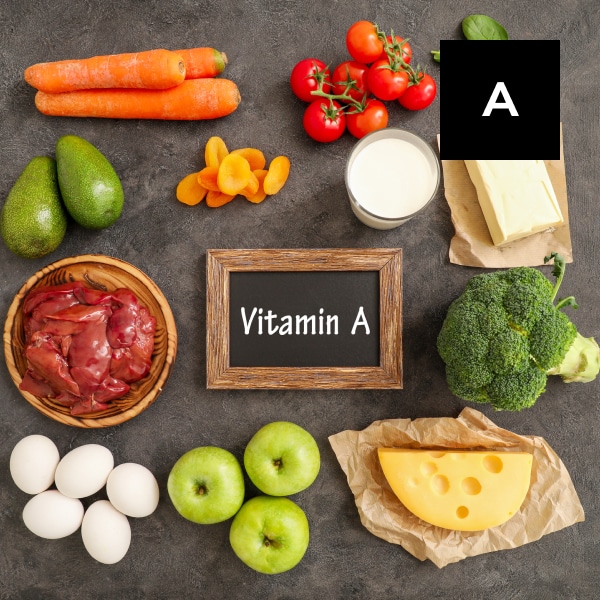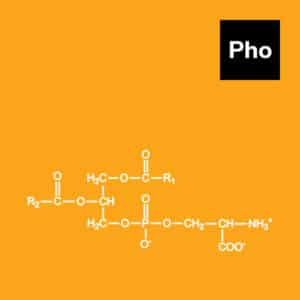Overview
There are two different types of vitamin A. Preformed vitamin A (Retinoids) is found in animal sources of food, meat (liver), egg yolk, poultry, fish (shrimp and salmon), and dairy products. It aids in night vision, the production of red blood cells, and the fight against infections.
The other type, provitamin A (carotenoids), is in plant foods such as orange veggies, spinach, and other greens, sweet potatoes, squash, cantaloupe, mangos, and apricots. It helps prevent damage to cells and age-related macular degeneration, and other eye diseases.
Key Benefits
- Supports healthy immunity
- Supports normal vision
- Supports normal function of the heart, lungs, kidneys, and other organs
- Essential for normal growth and reproduction
- Provides antioxidant support
History of Usage
Frederick Gowland Hopkins, an English biochemist, discovered unknown substances present in milk that were neither lipids, proteins, nor carbohydrates, but were essential for rat growth in 1912.
Hopkins was awarded the Nobel Prize for this discovery in 1929. One of these chemicals was discovered in 1917 by Elmer McCollum of the University of Wisconsin–Madison, Lafayette Mendel, and Thomas Burr Osborne of Yale University while exploring the effect of dietary lipids. These “accessory factors” were described as fat-soluble in 1918, and vitamin A was introduced in 1920.
Pregnant women first used vitamin A pills during their second trimester of pregnancy. Since 1998, the World Health Organization estimates that vitamin A treatment has prevented 1.25 million deaths caused by vitamin A deficiency in 40 countries.
Vitamin A is available as a standalone supplement as well as in multivitamins, most commonly in the form of retinyl acetate or retinyl palmitate. Some supplements contain beta-carotene, with the balance being preformed vitamin A; others contain solely preformed vitamin A or only beta-carotene.
The percentage of each vitamin type is frequently indicated on supplement labels. The levels of vitamin A found in stand-alone supplements vary greatly.
750–3,000 mcg RAE (2,500–10,000 IU) vitamin A is commonly found in both retinol and beta-carotene forms in multivitamin pills.
Vitamin A supplements are taken by approximately 28%–37% of the general population. Adults over the age of 71, as well as children under the age of nine, are more likely to take vitamin A supplements than other age groups.
Biochemistry
Retinol, retinal, and retinyl esters are all fat-soluble retinoids that make up vitamin A. It has an impact on immune function, vision, reproduction, and cellular communication. Immune function, eyesight, reproduction, and cellular communication are all affected by it. It is crucial for vision because it is a component of rhodopsin, a protein that absorbs light in the retinal receptors.
It promotes the correct differentiation and function of the conjunctival membranes and cornea. Likewise, it also promotes cell development and differentiation. Hence, it plays an important part in the correct formation and maintenance of the heart, lungs, kidneys, and other organs.
Vitamin A insufficiency is uncommon in the United States, but it is widespread in many underdeveloped nations. The most common sign of vitamin A deficiency in young children and pregnant women is xerophthalmia, or the inability to see in low light, which can lead to blindness if not addressed.
Animal-derived vitamin A is fat-soluble and, if consumed in large quantities, can accumulate in the body and become poisonous. Hair loss, disorientation, liver disease, and bone loss are all indications of an overdose.
Because plant-based vitamin A is water-soluble and does not build in the body, poisoning is uncommon. These plant-derived carotenoids provide the body with all the vitamin A it requires.
Recent Trends
The global vitamin A market is projected to grow at a CAGR of 4.2% between 2020 and 2027 and is expected to reach $615.85 million by 2027. The vitamin A market is growing rapidly because of increased awareness of its benefits in reducing age-related macular degeneration, glaucoma, and cataract risk. Also, increased consumer spending on cosmetic and skincare products should drive its growth.
Precautions
- Pregnant women who consume a lot of preformed vitamin A may have babies with birth problems. Women who may be pregnant should avoid using large amounts of vitamin A supplements.
- Excess preformed vitamin A (often from supplements or some medications) can induce dizziness, nausea, migraines, coma, and even death.
- The skin may color yellow-orange after consuming significant amounts of beta-carotene or other types of proform vitamin A, however this is a harmless condition.
- High beta-carotene intakes do not result in birth abnormalities or the other more significant side effects associated with taking too much preformed vitamin A.
- Individuals using prescription pharmaceuticals should consult with a health care professional before taking supplemental vitamin A because some medications interact with vitamin A intake.
References
- Johnson EJ, Russell RM. Beta-Carotene. In: Coates PM, Betz JM, Blackman MR, et al., eds. Encyclopedia of Dietary Supplements. 2nd ed. London and New York: Informa Healthcare; 2010:115-20.
- Ross CA. Vitamin A. In: Coates PM, Betz JM, Blackman MR, et al., eds. Encyclopedia of Dietary Supplements. 2nd ed. London and New York: Informa Healthcare; 2010:778-91.
- Ross A. Vitamin A and Carotenoids. In: Shils M, Shike M, Ross A, Caballero B, Cousins R, eds. Modern Nutrition in Health and Disease. 10th ed. Baltimore, MD: Lippincott Williams & Wilkins; 2006:351-75.
- Semba RD. On the “discovery” of vitamin A. Ann Nutr Metab. 2012;61(3):192-8. doi: 10.1159/000343124. Epub 2012 Nov 26. PMID: 23183288.
- Micronutrient Deficiencies-Vitamin A. World Health Organization. April 9, 2008.




